From 1892 – 1940, the Sisters of Mercy in Rochfortbridge, Co Westmeath ran a school for the education and training of deaf Catholic girls. What led to the foundation of St. Joseph’s Institute in a midlands village when there was an established school for deaf Catholic girls less than 50 miles away in St. Mary’s, Cabra, Dublin and what record remains of its 48 year history?
 Annals, Rochfortbridge, 1892
Annals, Rochfortbridge, 1892
Sadly, we are not aware of any institutional records surviving from St. Joseph’s in the form of student registers, administrative papers or correspondence with educational and local authorities and we are reliant on other sources to understand its story. The annals of the Rochfortbridge Mercy community, contemporary newspaper reports, census returns and publications on the history of the Sisters of Mercy of Rochfortbridge go some way to filling the gaps in the absence of the institutional record.
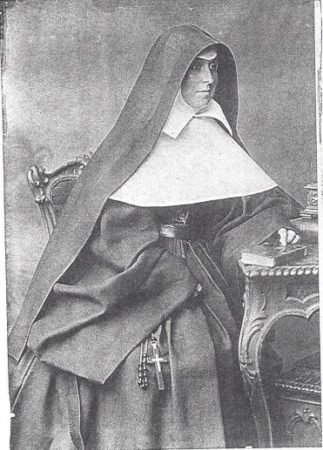 Mother Stanislaus O’Neill
Mother Stanislaus O’Neill
The Rochfortbridge annals record that Dr. Thomas Nulty, Bishop of Meath was anxious to establish an institute for deaf and dumb girls in the diocese. He asked the then Superioress, Mother Stanislaus O’Neill to undertake the work and she agreed to do so. Sr. Magdalene Claffey, in her history of Meath Mercy Convents, writes that it was said that Nulty had a close relative who was deaf and he had a special interest in their plight. The Mercy community in Rochfortbridge also had a strong connection with the family of Richard Coffey, a wealthy landowner and longstanding friend and benefactor of the convent, whose son, Dick was deaf. In 1876 Richard’s daughter, Emily, entered the community taking the name Sr. Mary Alacoque. When Sr. Alacoque died in 1934, word was sent to her brother, Dick. He, being a deaf-mute, would not come near the remains, although they had always been devoted to each other. (Annals 1934)
Funds were needed to set up and support the institute. Bishop Nulty provided income from a bequest and work began to use part of a building that had served as the original convent prior to the erection of a new convent in 1872. Mother Stanislaus sought and received support from the Board of Guardians of Mullingar Poor Law Union. The parish priest, Fr. Fagan arranged for a charity sermon to be preached by Dr. McCormack, Bishop of Galway, to clear the debt incurred in setting up the institute. Bishop Nulty gave £50 and the parishioners £132. This, with offerings from well-wishers brought the total to £300, which wiped out the debt. Bishop Nulty retained his interest in St. Joseph’s and when he died in 1897 he bequeathed canal shares for the upkeep of the institute.
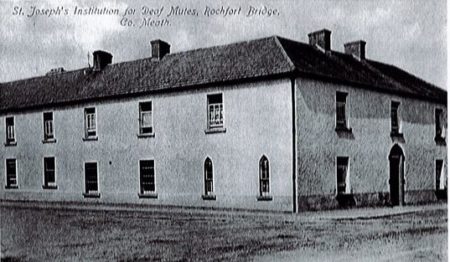 St. Joseph’s Institute, Rochfortbridge
St. Joseph’s Institute, Rochfortbridge
St. Joseph’s Institute opened on 24th November, 1892. A deaf-mute teacher, Charlotte Kelly, former governess to Richard Coffey, brother of Sr. Alacoque, was engaged to teach the children. St. Joseph’s shared premises with the convent primary school until 1896, when a new primary school was built and the entire building was handed over to provide additional space for the institute and its boarders.
When Charlotte Kelly died of influenza and bronchitis in 1898 she was succeeded by Miss Browne, who had trained as a teacher of the deaf in St. John’s, Boston Spa, England. She was later joined by Ellen Cronin, who had trained in St. Mary’s School for the Deaf, Cabra and who remained until 1903. Claffey notes that four Sisters of Mercy, Gertrude Smith, Brigid Brady, Antonio Kelly, and Patrick Noone learned sign language and worked with the children.
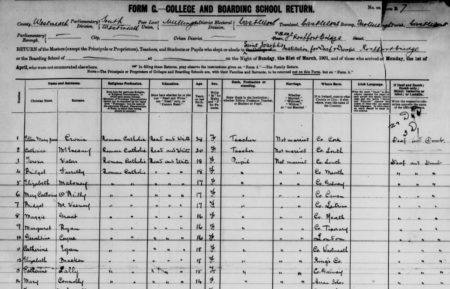 1901 Census, St. Joseph’s Institute
1901 Census, St. Joseph’s Institute
The census returns of 1901 and 1911 provide an insight into the numbers attending St. Joseph’s, their age range and places of origin. In 1901 there were 24 pupils and two teachers residing in the institute. The pupils ranged in age from 3 to 18 with the majority between 13 and 18. There were four from Westmeath, two from London with the remainder from all quarters of Ireland including Derry, Cork and the Aran Islands. The 1911 census records 31 residents with 20 aged 18 or younger and 11 aged 20 to 46. All were described as deaf only or deaf and dumb. Five students from 1901 were still in residence in 1911. The older age profile in 1911 may reflect the fact that St. Joseph’s curriculum included vocational skills training in addition to education. Claffey noted that two girls who had been trained in the Mercy Convent, Gort, Co Galway were engaged to teach lace making and sewing. Knitting machines were installed and lace, stockings and garments were produced to order.
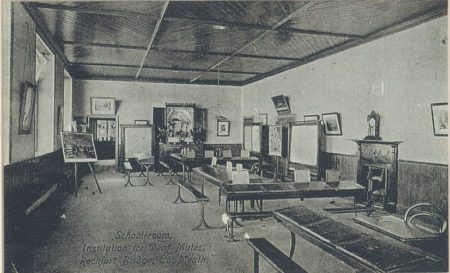 School Room in St. Joseph’s Institute
School Room in St. Joseph’s Institute
Further insight into St. Joseph’s is provided by two detailed articles in the Westmeath Examiner newspaper in 1906. The first focused on the industrial vocational training provided and encouraged readers to purchase its textile products and support the school and those who were educated and trained there. The second concentrated on the education provided and how students were taught, by means of objects, observance and motion of the lips and mouth, facial expression, pictures etc, by degrees patience and kindness and love are rewarded, and the poor deaf and dumb girl begins to be able to write questions or frame answers (Westmeath Examiner April 1906)
The annals also record some notable events in the life of the school. In 1899 a public concert was given. The students acted “The Babes in the Wood” in signs. They also danced an Italian folk dance called the Tarantella, a jig, and a skirt dance, in which dancers manipulated long, layered skirts with their arms to create a motion of flowing fabric. One night in 1910 the children noticed a blaze in St. Joseph’s coal shed, alerted the teachers who roused some locals to help. The children formed a chain and passed buckets of water to the men who extinguished the fire, saving fifteen tons of coal and a cask of paraffin oil and preventing its spread to the main building.
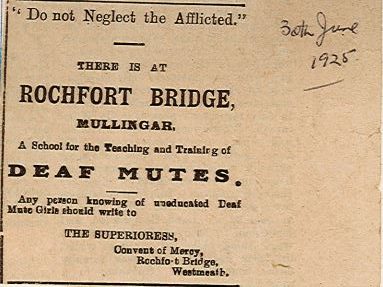 Newspaper Advert, 1925
Newspaper Advert, 1925
The number of enrolments in St. Joseph’s never exceeded 30 and gradually declined despite appeals to the local county councils and in the newspapers. Income declined in tandem with numbers. The annals noted that better facilities were available in St. Mary’s, Cabra and it was much more central. From the 1920’s children attending the convent primary schools who could not easily get to school began to board in St. Josephs and eventually only those boarders remained. St. Joseph’s Institute closed in 1940. The building’s educational role continued as it became a secondary top in 1948 and a recognised secondary school in 1954.
Sources
Annals of the Convent of Mercy Rochfortbridge
Westmeath Examiner 1892, 1906
Census of Ireland 1901, 1911
Claffey, Magdalene – History of Meath Mercy Convents 1836-1994
Dunne, Danny – To Serve with Gladness: Celebrating 150 years of the Sisters of Mercy, Rochfortbridge 2012
Marianne Cosgrave
Congregational Archivist


